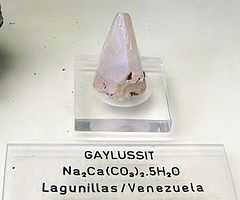Gaylussite
| Gaylussite | |
|---|---|
|
Gaylussite - Lagunillas, Venezuela | |
| General | |
| Category | Carbonate mineral |
| Formula (repeating unit) | Na2Ca(CO3)2·5H2O |
| Strunz classification | 05.CB.35 |
| Identification | |
| Color | Colorless, white, yellow, and grey |
| Crystal habit | Tabular prismatic crystals also granular |
| Crystal system | Monoclinic 2/m |
| Cleavage | perfect [110] |
| Fracture | Conchoidal, brittle |
| Mohs scale hardness | 2.5 |
| Luster | vitreous |
| Streak | white |
| Specific gravity | 1.93 - 1.99 |
| Optical properties | Biaxial (-) |
| Refractive index | nα = 1.444 nβ = 1.516 nγ = 1.523 |
| Birefringence | δ = 0.079 |
| Solubility | decomposes in water |
| Other characteristics | efflorescent |
| References | [1][2][3] |
Gaylussite is a carbonate mineral, a hydrated sodium calcium carbonate, formula Na2Ca(CO3)2·5H2O. It occurs as translucent, vitreous white to grey to yellow monoclinic prismatic crystals. It is an unstable mineral which dehydrates in dry air and decomposes in water.[1]
It is formed as an evaporite from alkali lacustrine waters. It also occurs rarely as veinlets in alkalic igneous rocks.[1] It was first described in 1826 for an occurrence in Lagunilla, Zulia, Venezuela. It was named for French chemist Joseph Louis Gay-Lussac (1778–1850).[2]
The mineral has been recently reported from drill core in Lonar lake in central India.[4]
References
- ↑ 1.0 1.1 1.2 Handbook of Mineralogy
- ↑ 2.0 2.1 Mindat
- ↑ Webmineral
- ↑ Anoop et al., Palaeoenvironmental implications of evaporative gaylussite crystals from Lonar Lake, central India, Journal of Quaternary Science, V., Issue 4, pp. 349–359, May 2013
| Wikimedia Commons has media related to Gaylussite. |
